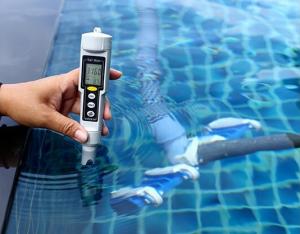Water Quality Monitor Systems Market Emerging Trends with Impact of COIV-19 and Growth Projections by 2025
Global Water Quality Monitor Systems 2018-2025: Business Development and Growth Opportunities by Industry Expert
PORTLAND, OREGON, UNITED STATES, November 26, 2020 /EINPresswire.com/ -- Global Water Quality Monitoring Systems Market was valued at $3,815.9 million in 2017 and is expected to reach $6,692.3 million by 2025, growing at a CAGR of 7.3% from 2018 to 2025. The pH sensors segment dominated the global market in terms of revenue, accounting for more than 30.9% share in 2018 and is expected to witness significant growth during the forecast period.Water quality monitoring system is a process of monitoring and sampling water quality. It includes measuring and analyzing various pollutants such as oils, petrochemicals, asbestos, lead, mercury, phosphates, and nitrates. These systems are implemented in quality estimation of groundwater, drinking water, wastewater, aquaculture, and laboratory applications. The water quality monitoring system consists of sensors such as temperature sensor, pH sensor, dissolved oxygen, and turbidity sensor, which detect the parameters related to pollutants. These sensors are used to identify pH, inorganic compounds, organic materials, and other pollutants.
Download Sample PDF@ https://www.alliedmarketresearch.com/request-sample/5063
The growth of the global water quality monitoring systems market is driven by rise in awareness about clean water in urban population. Increase in prevalence of waterborne diseases boosts the demand for water quality monitor systems across the world. Thus, these factors are anticipated to provide potential opportunities for the key players operating in the market. However, water quality monitoring equipment is expensive, and its maintenance & operation costs are very high. Lack of understanding and awareness about contaminated water in rural places restricts the growth of the global water quality monitoring systems market. Rise in disposable income of consumers increases the development opportunities in this market.
The pH sensor segment contributed nearly one-third of the total market share in 2017 and is expected to maintain its lion's share through 2025. Moreover, this segment would register the highest CAGR of 7.7% from 2018 to 2025, owing to the applicability of pH sensors in a wide range of applications in various sectors. The market research report also offers detailed analysis of several components including DO sensors, temperature sensors, turbidity sensors, and others.
Based on application, the residential segment is expected to account for the highest CAGR in the global market during the forecast period owing to increase in government initiatives in the Asia-Pacific region. Based on component, the pH sensor segment is expected to account for a maximum share, growing at a significant CAGR during the forecast period. This is attributed to the decline in cost of sensors, which in turn has propelled their adoption in residential and commercial segments.
For Purchase Enquiry@ https://www.alliedmarketresearch.com/purchase-enquiry/5063
Utilities segment accounted for nearly half of the total market share in 2017 and will continue to be the largest revenue contributor throughout the forecast period, owing to their growing demand in storage, transportation, and treatment processes. However, the residential segment would grow at the fastest CAGR of 8.3% from 2018 to 2025, owing to the rising pollution of drinking water and increasing prevalence waterborne diseases. The other end users analyzed in the research include industrial and commercial segments.
North America is the highest contributor to the global water quality monitoring systems market in terms of revenue in 2018 and is expected to maintain its dominance during the forecast period, owing to use of modern technologies, presence of developed economies, and increase in manufacturing and industrial activities.
Get detailed COVID-19 impact analysis on the Water Quality Monitoring Systems Market @ https://www.alliedmarketresearch.com/request-for-customization/5063?reqfor=covid
Prominent players, such as Danaher Corporation, Evoqua Water Technologies, General Electric Company, Horiba, Ltd., OAKTON Instruments, Pentair, Shimadzu Corporation, Thermo Fisher Scientific, Inc., Uponor, and Xylem Inc., have adopted new product launch as their key strategy to expand their market foothold.
Key Findings of the Water Quality Monitoring Systems Market :
• In 2017, the pH sensor segment dominated the global water quality monitoring systems market, in terms of revenue, and is projected to grow at a CAGR of 7.7% during the forecast period.
• The DO sensor segment is anticipated to grow at a CAGR of 7.3% during the forecast period.
• Based on application, the residential segment is projected to grow at a highest CAGR of 8.3% during the forecast period.
• Asia-Pacific generated $732.3 million revenue in 2017 and is anticipated to grow at a significant CAGR.
• Asia-Pacific is estimated to exhibit the highest CAGR during the forecast period. Countries, such as China, Japan, South Korea, and India are expected to drive the Asia-Pacific water quality monitoring systems market during the forecast period.
Contact us:
David Correa
5933 NE Win Sivers Drive
#205, Portland, OR 97220
United States
Toll Free: 1-800-792-5285
UK: +44-845-528-1300
Hong Kong: +852-301-84916
India (Pune): +91-20-66346060
Fax: +1-855-550-5975
help@alliedmarketresearch.com
Web: www.alliedmarketresearch.com
Follow us on: https://www.linkedin.com/company/allied-market-research
David Correa
Allied Analytics LLP
+ +1 800-792-5285
help@alliedanalytics.com
Visit us on social media:
Facebook
Twitter
LinkedIn

